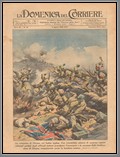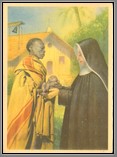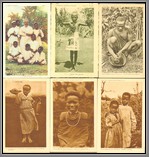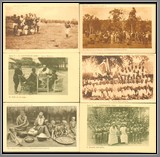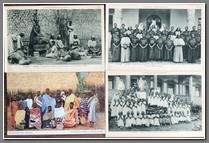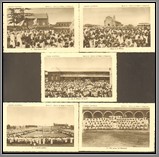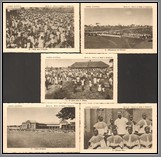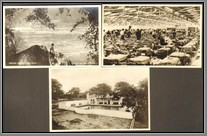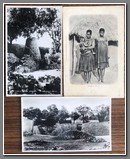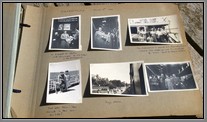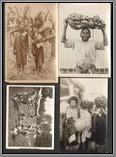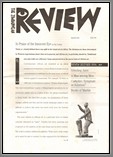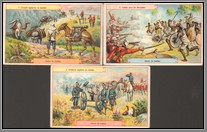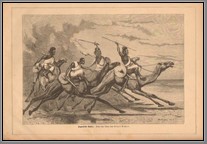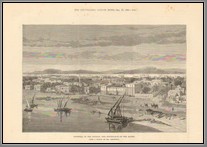British East / Central Africa
Photo album of a group of Heart of Africa (WES International) missionaries to East Africa from 1958-1960. Well annotated with a number of missionaries mentioned by name. Places shown include Karble, Nabugabo, Gahina, Ruanda-Urundi, Eastern and Northern Provinces of Uganda. 174 photos in all. M
Price: $900.00
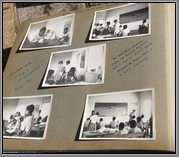 BRA 122 BRA 122 | 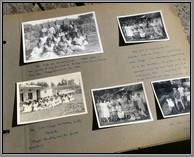 BRA 122 BRA 122 | 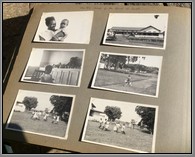 BRA 122 BRA 122 | 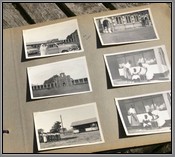 BRA 122 BRA 122 |
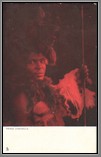 BRA 111Postcard of Prince Logenguela, postmarked 1903. M KN
BRA 111Postcard of Prince Logenguela, postmarked 1903. M KN
Price: $90.00
Note: Peter Kushana Lobengula claimed to be the son of the Ndebele King Lobengula Khumalo (1845–1894). He migrated to Britain and fell in with the circus owner Frank Fillis, whose show was the largest African exhibition ever held in London. Over two hundred Africans and dozens of Afrikaners were brought to London to re-enact battles, songs and dances in front of paying crowds. A film was made of the Africans arriving at Southampton docks and featured dozens of Zulus in dance showing their military agility. This film from 1899 is one of the earliest to show Africans. At Earl’s Court, the performers worked in a vast mock village that was deliberately made to look like an African kraal. Fillis also imported animals, props such as shields and spears and costumes for all of the performers. This attention to detail was intended to make anyone going to the show feel as if they had been transported to Africa without ever leaving London. When the show opened, Peter said: ‘My first thought was that the whole world was white men, and that they had all come to England to meet me!’ At first the show was a huge hit with around 16,000 visitors a day. Later on, public interest waned with the outbreak of the Boer War and in January 1900 the show was cancelled. By April, Fillis had begun touring Britain with only a few dozen Africans, including Peter, and, once again, the show proved popular. He married a woman named Kitty but they divorced in 1902. He subsequently married Maud Wilson and they raised five children. He died from consumption in 1913 at the age of 38 and is buried in Salford.
A collection of 46 illustrations from English, French and Italian periodicals on the Mahdist Jihad in the Sudan, 1881-1885. B
Price: $900.00
Note: After the British removal of the the Egyptian Khedive Ismail in 1877, Gordon ( who had appointed him to the post) resigned as Governor General of Sudan in 1880. His successors lacked direction from Cairo and feared the political turmoil that engulfed Egypt. As a result, they failed to continue the policies Gordon had put in place.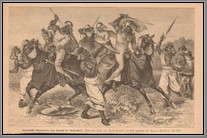 BRA 085
BRA 085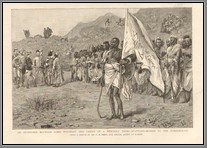 BRA 085 The illegal slave trade revived, although not enough to satisfy the merchants whom Gordon had put out of business. The Sudanese army suffered from a lack of resources, and unemployed soldiers from disbanded units troubled garrison towns. Tax collectors arbitrarily increased taxation.
BRA 085 The illegal slave trade revived, although not enough to satisfy the merchants whom Gordon had put out of business. The Sudanese army suffered from a lack of resources, and unemployed soldiers from disbanded units troubled garrison towns. Tax collectors arbitrarily increased taxation.
In this troubled atmosphere, Muhammad Ahmad ibn as Sayyid Abd Allah, a faqir or holy man who combined personal magnetism with religous zealotry, emerged, determined to expel the Turks and restore Islam to its primitive purity. 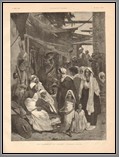 BRA 085
BRA 085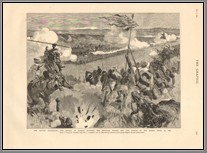 BRA 085Sometime in 1880 Muhammad Ahmad revealed himself as ‘the Mahdi’, sent from God to redeem the faithful and prepare the way for the second coming of the Prophet Isa (Jesus). Even after the Mahdi proclaimed a jihad, or holy war, against the Turks, Khartoum dismissed him as a fanatic, that is until his zealotry turned to denunciating tax collectors. To avoid arrest, the Mahdi and a pary of his followers, the Ansar, made a long march to Kurdufan, where he gained a large number of recruits.
BRA 085Sometime in 1880 Muhammad Ahmad revealed himself as ‘the Mahdi’, sent from God to redeem the faithful and prepare the way for the second coming of the Prophet Isa (Jesus). Even after the Mahdi proclaimed a jihad, or holy war, against the Turks, Khartoum dismissed him as a fanatic, that is until his zealotry turned to denunciating tax collectors. To avoid arrest, the Mahdi and a pary of his followers, the Ansar, made a long march to Kurdufan, where he gained a large number of recruits.
Early in 1882, the Ansar, armed with spears and swords, overwhelmed a 7,000 man Egyptian force not far from Al Ubayyid and seized their rifles and ammunition. The Mahdi followed up this victory by laying siege 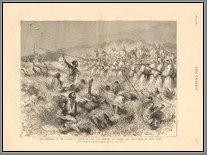 BRA 085
BRA 085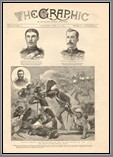 BRA 085to Al Uyayyid and starving it into submission after four months. The Ansar, 30,000 men strong, then defeated an 8,000 man Egyptian relief force at Sheikan. Next the Mahdi captured Darfur. These successes threatened to cut off garrisons at Khartoum, Kassala, Sannar and Sawakin and in the south. To avoid a costly conflict, the British government ordered an Egyptian withdrawl from Sudan. Gordon, who had received a reappointment as governor general, arranged to supervise the evacuation of Egyptian troops and all foreigners from Sudan.
BRA 085to Al Uyayyid and starving it into submission after four months. The Ansar, 30,000 men strong, then defeated an 8,000 man Egyptian relief force at Sheikan. Next the Mahdi captured Darfur. These successes threatened to cut off garrisons at Khartoum, Kassala, Sannar and Sawakin and in the south. To avoid a costly conflict, the British government ordered an Egyptian withdrawl from Sudan. Gordon, who had received a reappointment as governor general, arranged to supervise the evacuation of Egyptian troops and all foreigners from Sudan.
Upon reaching Khartoum in February 1884, Gordon realized he could not extricate the garrsions and called for reinforcements from Egypt to relieve Khartoum. He argued that Sudan was essential to Egypt’s security and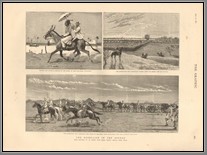 BRA 085
BRA 085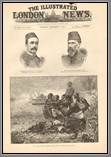 that to allow the Ansar a victory there would invite the movement to spread elsewhere. Increasing popularity of Gordon at home forced Prime Minister Gladstone to mobilize a relief force under the command of Lord Wolseley. The relief column got bogged down at Abu Klea where the so-called Fuzzy Wuzzies broke the British line. Another advance unit that had gone by river reached Khartoum on January 28, 1885, only to find the town had fallen two days earlier.The garrison was slaughtered and Gordon’s head was delivered to the Mahdi’s tent. Kassala and Sannar fell soon after and by the end of 1885 the Ansar had begun to move into the southern region. In all Sudan, only Sawakin, reinforced by Indian troops, and Wadi Haifa on the northern frontier, remained in Anglo-Egyptian hands.
that to allow the Ansar a victory there would invite the movement to spread elsewhere. Increasing popularity of Gordon at home forced Prime Minister Gladstone to mobilize a relief force under the command of Lord Wolseley. The relief column got bogged down at Abu Klea where the so-called Fuzzy Wuzzies broke the British line. Another advance unit that had gone by river reached Khartoum on January 28, 1885, only to find the town had fallen two days earlier.The garrison was slaughtered and Gordon’s head was delivered to the Mahdi’s tent. Kassala and Sannar fell soon after and by the end of 1885 the Ansar had begun to move into the southern region. In all Sudan, only Sawakin, reinforced by Indian troops, and Wadi Haifa on the northern frontier, remained in Anglo-Egyptian hands.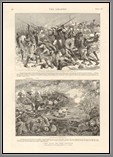 BRA 085
BRA 085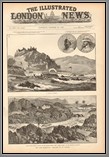 BRA 085
BRA 085
Six months after the fall of Khartoum, the Mahdi died of typhus. The task of establishing and maintaining a government fell to his deputies – 3 caliphs chosen by the Mahdi in emulation of the Prophet Muhammad. Rivalry among the three continued until 1891, when Abdallahi ibn Muhammad, with the help primarily of the Baqqara Arabs, overcame the opposition of the others and emerged as unchallenged leader of the Mahdiyah. Abdallahi – called the Khalifa (successor) – purged the Mahdiyah of members of the Mahdi’s family and many of his early religous disciples.
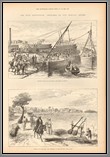 BRA 085 BRA 085 | 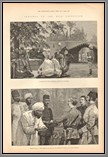 BRA 085 BRA 085 | 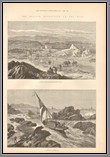 BRA 085 BRA 085 | 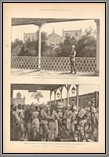 BRA 085 BRA 085 | 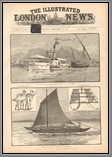 BRA 085 BRA 085 | 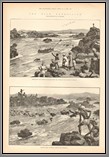 BRA 085 BRA 085 |

